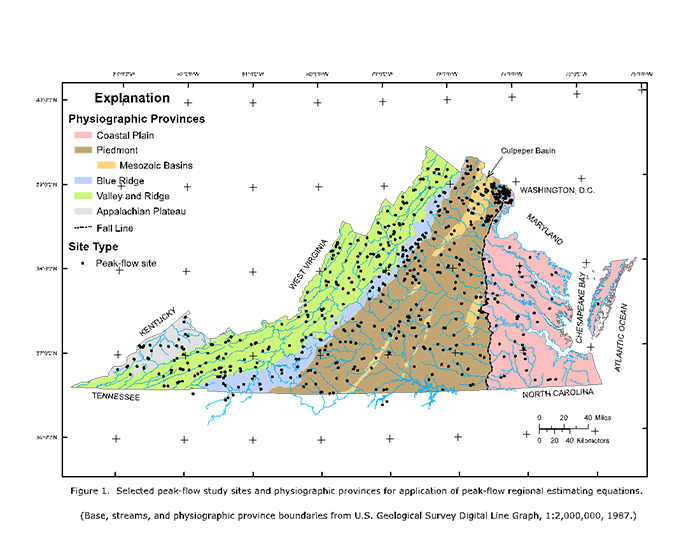Project Information
Title:
Peak-Flow Characteristics of Virginia Streams
Number:
2482-9RQ11
Location:
Commonwealth of Virginia
Cooperating Agencies:
Virginia Department of Transportation
Project Chief:
Samuel H. Austin
Period of Project:
2005 to present
Publications:
Drainage Areas of Selected Streams in Virginia
Annual Maximum Stages and Discharges of Selected Streams in Virginia through 2007
Peak-Flow Characteristics of Virginia Streams
USGS IN YOUR STATE
USGS Water Science Centers are located in each state.

|
Peak-Flow Characteristics of Virginia Streams
Needs
Economic growth, and the development, management, and protection of Virginia’s natural resources require anticipating peak stream flows and changes in peak stream flows over time. Extensive hydraulic analysis and smart design are needed to limit the environmental impacts of buildings, pavements, highways, and bridges. Effective design and placement of structures built near streams and on flood plains requires an understanding of peak discharges and basin characteristics of streams. Knowledge of the magnitude and frequency of peak discharge is needed to construct highway bridges and culverts, locate transportation infrastructure, and design flood-control structures. Knowledge of basin characteristics is needed to use peak flow characteristics at ungaged locations.
Scientific Investigations
These needs are addressed through cooperative study and a series of scientific investigations.
- Digital basin boundaries have been determined at approximately 550 current and historic surface-water gaging stations. They may be found here: https://pubs.usgs.gov/of/2006/1308/
- Annual flood-peak data have been summarized for over 500 Virginia stream gaging stations, and may be found here: https://pubs.usgs.gov/of/2009/1007/
- Peak-Flow characteristics have been analyzed and summarized for 476 Virginia stream gaging stations. Statewide regional regression equations describing peak-flow characteristics at ungaged locations have been developed. These may be found here: https://pubs.usgs.gov/sir/2011/5144/
- Models and equations for estimating Virginia urban basin peak water discharge per square mile are in development. They describe urban area peak discharge per square mile as a function of percent urban area, and basin drainage area, for basins anywhere in Virginia with urban land use ranging from 10-percent to 96-percent, and basin drainage area ranging from 0.07 square-miles to 2,404 square-miles. Check here soon for more information about acquiring and using these urban models and equations.
- Curves and equations are being developed to describe the actual chance of a particular peak flow event occurring. One of the more confusing concepts in flow prediction is the idea of an average recurrence interval associated with a particular peak flow. It is possible for a 20-year event to occur in each of two consecutive years, or not to occur at all during 30 consecutive years or more. When using calculations of the average frequency of peak flows, therefore, one should take note of the variation in their occurrence. This set of curves and equations will help determine the actual chance of a particular peak flow event occurring, as a function of the average recurrence interval of an event and the number of years in the interval within-which the event may occur. Check here soon for more information about acquiring and using these curves and equations.
A Network of Peak-Flow Gaging Stations
Since 1949, the USGS, in cooperation with the Virginia Department of Transportation (VDOT), has maintained a network of partial-record peak-discharge gaging stations. These, combined with other continuous-record gaging stations, provide annual peak-discharge data at more than 550 gaging station locations throughout Virginia. Most of these gages have 10 years or more of peak-discharge data. Data from these gages may be found here: https://nwis.waterdata.usgs.gov/usa/nwis/peak
The Benefits of Quality Data and Science
Quality peak-flow data, combined with continued collaborative scientific investigation, provide uniquely useful application oriented information and analyses vital to understanding, anticipating, and better managing Virginia’s stream flows, basins, and ecosystems.
|

